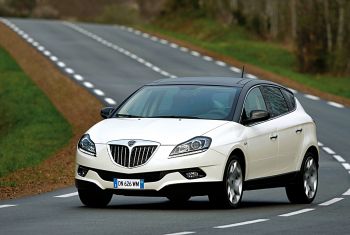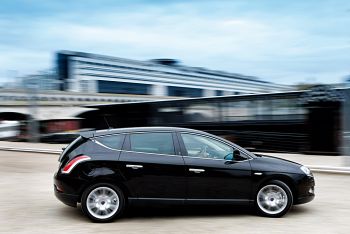|
Delta: a
name that is a legend in motoring
|
|
The Lancia Delta
was created in the autumn of 1979 and was voted Car of the
Year in 1980 by a panel of motoring journalists. With its
up-to-date characterful body and high-performing engine, the
model represented a generation leap in terms of the overall
car concept and its engineering, aesthetic and quality
aspects. Unsurprisingly, the car also met with immediate
acclaim from the public, who found in the Delta all the
excellent performance, attention to finish detail and
material quality that they had come to expect from the great
Lancia cars.
The pen of Giorgetto Giugiaro was responsible for the
hatchback shape, conceived as a trapezoid shape with very
angular outlines. Other brand-new features were front and
rear shields incorporating the bumpers and produced in
polyester resin reinforced with glass fibre.
The mechanical configuration was front wheel drive with a
transverse engine, all round independent suspension, braking
system with two crossover circuits and rack and pinion
steering. Two power units were available at the launch: a 75
bhp 1.3 unit and a 85 bhp 1.5 bhp unit. Both featured a
timing system with overhead camshaft driven by a toothed
belt and a light alloy cylinder head.
The Delta's overall appearance was that of an elegant,
compact car, just under four metres in length. The date was
1979 and the Delta, though only a medium-sized car, offered
all the equipment of a top-class car as standard (power
windows, for example). With its innovative styling and
content typical of higher segments, Lancia had hit on a new
compact car concept that immediate won both critical and
public acclaim.
|
 |
|
|
 |
|
|
|

 |
|
Production of the Delta began at the Lingotto plant
in Turin and was then transferred to the Chivasso plant that
housed one of the advanced paint shops in the world, an
electronically-controlled body machining system and an
automatic system to ensure absolutely uniform subunit
quality. This plant was responsible for the personalised LX
versions and, in 1982, a Delta GT with a 105 bhp 1.6 engine.
The car was equipped with four disc brakes power-assisted by
a brake servo and reached a top speed of 180 km/h.
In 1983, four years after the modelís debut, we welcomed the
Delta HF Turbo, the first standard-production Lancia car
equipped with a turbocharger. The engine was the same 1583
cc unit, but delivered a power output of 130 bhp that
allowed a top speed of 190 bhp.
Three years later, in 1986, the model range was revived and
extended by the 108 bhp Delta GT with electronic injection,
the 80 bhp Turbodiesel 2.0, the HF Turbo injection (140 CV)
and the HF 4WD. The latter, together with the Prisma 4WD,
marked Lancia's first foray into the four wheel drive
touring saloon sector. It was equipped with a 165 bhp two
litre engine (208 km/h of top speed) and state-of-the-art
mechanical components. The drive system consisted of a free
front differential, an epicyclic central differential that
distributed torque asymmetrically (56% to the front axle and
44% to the rear), a Ferguson viscous coupling applied to the
central differential and a Torsen rear differential (Torsen
is short for 'torque sensing'), a smart device that allowed
torque to be distributed over both wheels according to the
available grip, without ever allowing both half-axles to
lock fully. In this way, the Delta HF 4WD was able to
transfer all the engineís power effectively to the ground.
The result was a car with great traction over slippery
surfaces, offering excellent directional stability and
road-holding at higher speeds. In later years, the four
wheel drive Delta was enhanced by a long list of technical
and stylistic improvements, mainly dictated by rally needs.
Sporting versions of the Delta won no fewer than six world
rally titles between 1987 and 1992. The Delta remained in
production from 1979 to 1994 and its total production
amounted to 480,000 cars. |
|